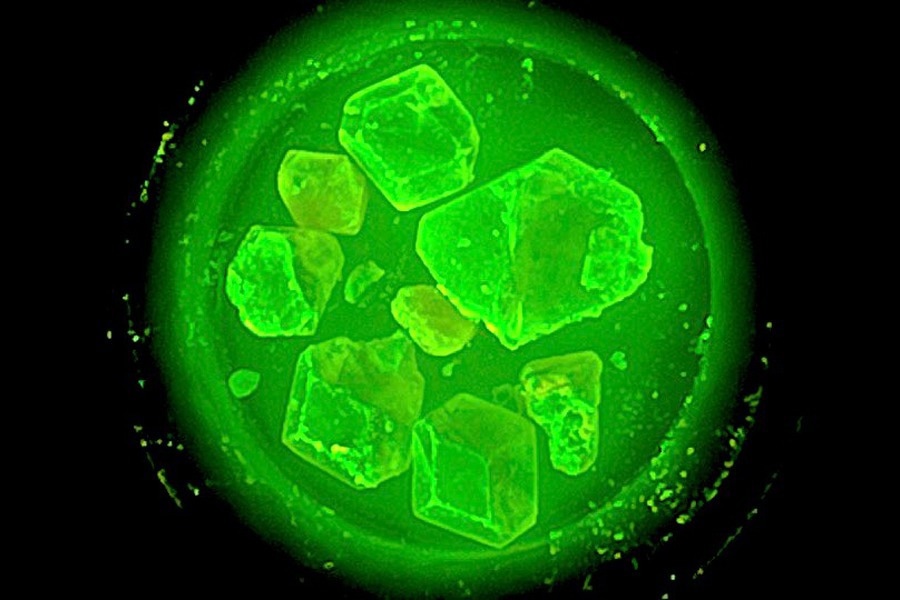A group of scientists from Florida State University has generated a new generation of organic-inorganic hybrid materials that can enhance image quality in CT scans, X-Ray machines, and other radiation detection and imaging technologies.
 A zero-dimensional organic metal halide hybrid scintillator shining under radiation. Image Credit: Biwu Ma
A zero-dimensional organic metal halide hybrid scintillator shining under radiation. Image Credit: Biwu Ma
These new materials, which could function effectively as scintillators, have been created by Professor Biwu Ma from the Department of Chemistry and Biochemistry and his colleagues. These materials generate light when subjected to X-Rays and other high-energy radiations.
The team’s most recent research, published in the journal Advanced Materials, builds on their earlier work to create better scintillators. Better imaging is made possible by the new design idea, which produces materials that can emit light in only a few nanoseconds, orders of magnitude quicker than previously created materials.
Reducing the radioluminescence decay lifetime of scintillators to nanoseconds is an important breakthrough. Using a hybrid material made up of both organic and inorganic components means each component can be used for the part of the process where it is most effective.
Biwu Ma, Professor, Department of Chemistry and Biochemistry, Florida State University
Numerous imaging applications employ scintillators. Better image quality would be advantageous for using them in healthcare facilities, security X-Rays, radiation detectors, and other technologies.
The organic metal halide hybrid scintillators produced by Ma’s team have many advantages over previous versions. In addition to having a much greater radioluminescence response, the production procedure is easier than that of other scintillators and requires a few easily accessible, inexpensive components.
What is Different About This Scintillator?
Consider a scintillator as an energy translator that transforms high-energy radiation, such as an X-Ray, into visible light. Denser portions of an item absorb less radiation, and this differential can be used to separate higher-density materials like bones or metal from lower-density ones like soft tissue.
The scintillator reacts with the radiation that travels through an object next, producing visible light that is recorded by a sensor to generate an image.
Today’s scintillators convert high-intensity radiation into visible light to create images mostly using inorganic materials. These materials must be produced using energy-intensive, high-temperature procedures, rare Earth elements, and rigidity.
Since 2018, Ma and his colleagues have been doing ground-breaking research on zero-dimensional organic metal halide hybrids. These organic-inorganic hybrids are comprised of positively charged organic molecules and small groups of negatively charged inorganic elements known as metal halide clusters.
The metal halide clusters are completely segregated from one another and encircled by organic molecules, making them “zero-dimensional” at the molecular level.
The metal halides in the first iteration of scintillators made from this material absorb high-energy radiation and produce visible light. In this most recent version, organic molecules and metal halide components collaborate. The organic components, which create visible light, receive energy from the metal halides after they have absorbed high-energy radiation.
Organic molecules emit light on a nanosecond time scale, which is far quicker than the milliseconds or microseconds needed for metal halides to generate light.
Ma added, “The faster the decay of radioluminescence, the more precise we can measure the timing of photon emissions. That leads to higher resolution and contrast in images.”
What is Next?
Ma and his group have submitted patent applications for organic metal halide hybrid scintillators with the assistance of the FSU Office of Commercialization.
The technology was developed with funding from the office’s GAP Commercialization Investment Program in preparation for prospective collaborations with private companies that would increase the accessibility of the scintillators.
“This is a continuation of our push for better materials over the years, from 2018, when we first discovered this class of materials, to 2020, when we used them for scintillation for the first time. This is another major breakthrough,” Ma further stated.
The National Science Foundation and Florida State University provided funding for this study.
Tunde Blessed Shonde, a graduate student at FSU, is the study’s first author.
He Liu, Oluwadara, and Maya Chaaban were other co-authors. All of the other co-authors were from FSU, including Luis M. Stand and Mariya Zhuravleva, Azza Ben-Akacha, Fabiola G. Gonzalez, Kerri Julevich, Xinsong Lin, and J. S. Raaj Vellore Winfred from the University of Tennessee, Knoxville.
Journal References:
- Shonde, T. B., et al. (2023) Molecular Sensitization Enabled High Performance Organic Metal Halide Hybrid Scintillator. Advanced Materials. doi:10.1002/adma.202301612.
- He, Q., et al. (2020) Highly Stable Organic Antimony Halide Crystals for X-ray Scintillation. ACS Materials Letters. doi:10.1021/acsmaterialslett.0c00133.